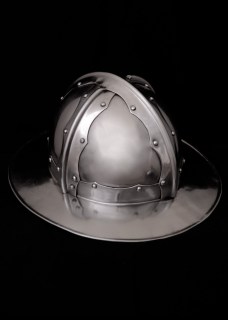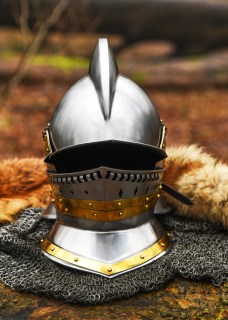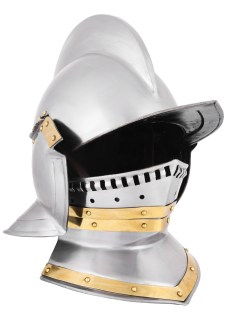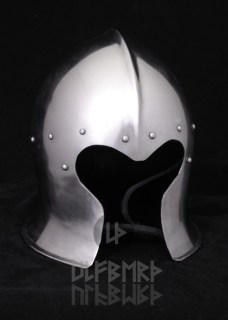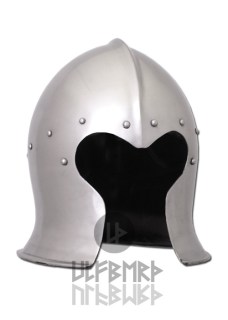
Cabasset Helmet
|
The morion helmet is a type of open-faced combat helmet originally from the Kingdom of Castile, in Spain. This fantastic Cabasset model is decorated with little brass roses. These medieval helmets are produced in Italy by expert Italian blacksmiths and craftsmen, for generations we have passed down the art of producing helmets and armor, using the best raw materials.
Details:
The cabasset, in Spanish "capacete", it was also worn during the 16th century and also originated in Spain, but it is unclear if it predated the morion or was an adaptation of it. The word is likely to derive from the Spanish word "cabeza" although some sources point towards the word "pear" in an Italian dialect, making reference to the stalk-like projection of the helmet, which resembles the fruit.
They were produced mainly in Calatayud, a town in Aragon. Like morions, it was worn by infantry in the pike and shot formations. It was popular in 16th-century England and was used during the Civil War. Several of these helmets were taken to the New World by the Pilgrim fathers, and one of these has been found on Jamestown Island.This fantastic Cabasset model is decorated with little brass roses.Inside the helmet there are strips of leather and string for maximum comfort.
There are yet no reviews for this product.
|
Related Products
|
130,00 € Salesprice with discount 98,00 € -25% Sales price without tax 98,00 € Discount -32,00 € Tax amount |
|
Salesprice with discount 620,00 € Discount Tax amount |
|
215,00 € Salesprice with discount 199,00 € -7% Sales price without tax 199,00 € Discount -16,00 € Tax amount |
|
Salesprice with discount 99,00 € Discount Tax amount |
|
Salesprice with discount 395,00 € Discount Tax amount |
|
Salesprice with discount 19,00 € Discount Tax amount |
|
Salesprice with discount 128,00 € Discount Tax amount |
|
Salesprice with discount 480,00 € Discount Tax amount |
|
Salesprice with discount 129,00 € Discount Tax amount |
|
Salesprice with discount 70,00 € Discount Tax amount |
|
Salesprice with discount 68,00 € Discount Tax amount |
|
Salesprice with discount 116,00 € Discount Tax amount |


